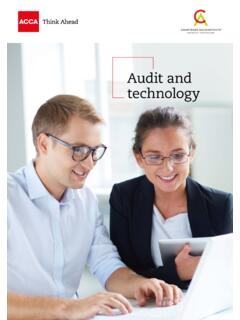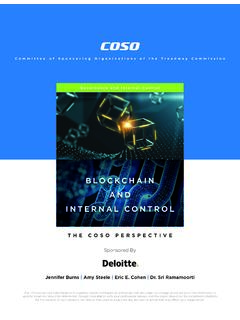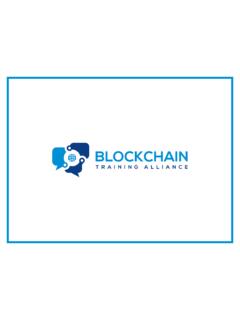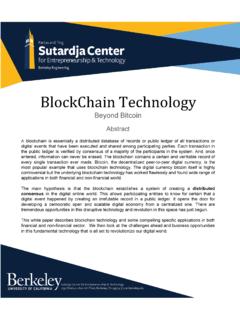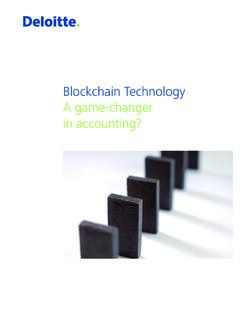Transcription of Blockchain Technology Overview - NIST
1 NISTIR 8202 Blockchain Technology Overview Dylan Yaga Peter Mell Nik Roby Karen Scarfone This publication is available free of charge from: NISTIR 8202 Blockchain Technology Overview Dylan Yaga Peter Mell Computer Security Division Information Technology Laboratory Nik Roby G2, Inc. Annapolis Junction, MD Karen Scarfone Scarfone Cybersecurity Clifton, VA This publication is available free of charge from: October 2018 Department of Commerce Wilbur L. Ross, Jr., Secretary National Institute of Standards and Technology Walter Copan, NIST Director and Under Secretary of Commerce for Standards and TechnologyNational Institute of Standards and Technology Internal Report 8202 66 pages (October 2018) This publication is available free of charge from: Certain commercial entities, equipment, or materials may be identified in this document in order to describe an experimental procedure or concept adequately.
2 Such identification is not intended to imply recommendation or endorsement by NIST, nor is it intended to imply that the entities, materials, or equipment are necessarily the best available for the purpose. There may be references in this publication to other publications currently under development by NIST in accordance with its assigned statutory responsibilities. The information in this publication, including concepts and methodologies, may be used by federal agencies even before the completion of such companion publications. Thus, until each publication is completed, current requirements, guidelines, and procedures, where they exist, remain operative.
3 For planning and transition purposes, federal agencies may wish to closely follow the development of these new publications by NIST. Organizations are encouraged to review all draft publications during public comment periods and provide feedback to NIST. Many NIST cybersecurity publications, other than the ones noted above, are available at Comments on this publication may be submitted to: National Institute of Standards and Technology Attn: Computer Security Division, Information Technology Laboratory 100 Bureau Drive (Mail Stop 8930) Gaithersburg, MD 20899-8930 Email: All comments are subject to release under the Freedom of Information Act (FOIA).
4 NISTIR 8202 Blockchain Technology Overview ii This publication is available free of charge from: Reports on Computer Systems Technology The Information Technology Laboratory (ITL) at the National Institute of Standards and Technology (NIST) promotes the economy and public welfare by providing technical leadership for the Nation s measurement and standards infrastructure. ITL develops tests, test methods, reference data, proof of concept implementations, and technical analyses to advance the development and productive use of information Technology . ITL s responsibilities include the development of management, administrative, technical, and physical standards and guidelines for the cost-effective security and privacy of other than national security-related information in federal information systems.
5 Abstract Blockchains are tamper evident and tamper resistant digital ledgers implemented in a distributed fashion ( , without a central repository) and usually without a central authority ( , a bank, company, or government). At their basic level, they enable a community of users to record transactions in a shared ledger within that community, such that under normal operation of the Blockchain network no transaction can be changed once published. This document provides a high-level technical Overview of Blockchain Technology . The purpose is to help readers understand how Blockchain Technology works. Keywords Blockchain ; consensus model; cryptocurrency; cryptographic hash function; asymmetric-key cryptography; distributed ledger; distributed consensus algorithm; proof of work; proof of stake; round robin; proof of authority; proof of identity; proof of elapsed time; soft fork, hard fork; smart contracts; data oracle.
6 NISTIR 8202 Blockchain Technology Overview iii This publication is available free of charge from: Acknowledgments The authors wish to thank all contributors to this publication, and their colleagues who reviewed drafts of this report and contributed technical and editorial additions. This includes NIST staff James Dray, Sandy Ressler, Rick Kuhn, Lee Badger, Eric Trapnell, Mark Trapnell, James Shook and Michael Davidson. Additional thanks to all the people and organizations who submitted comments during the public comment period. Audience This publication is designed for readers with little or no knowledge of Blockchain Technology who wish to understand at a high level how it works.
7 It is not intended to be a technical guide; the discussion of the Technology provides a conceptual understanding. Note that some examples, figures, and tables are simplified to fit the audience. Trademark Information All registered trademarks and trademarks belong to their respective organizations. NISTIR 8202 Blockchain Technology Overview iv This publication is available free of charge from: Executive Summary Blockchains are tamper evident and tamper resistant digital ledgers implemented in a distributed fashion ( , without a central repository) and usually without a central authority ( , a bank, company, or government). At their basic level, they enable a community of users to record transactions in a shared ledger within that community, such that under normal operation of the Blockchain network no transaction can be changed once published.
8 In 2008, the Blockchain idea was combined with several other technologies and computing concepts to create modern cryptocurrencies: electronic cash protected through cryptographic mechanisms instead of a central repository or authority. The first such Blockchain based cryptocurrency was Bitcoin. Within the Bitcoin Blockchain , information representing electronic cash is attached to a digital address. Bitcoin users can digitally sign and transfer rights to that information to another user and the Bitcoin Blockchain records this transfer publicly, allowing all participants of the network to independently verify the validity of the transactions. The Bitcoin Blockchain is stored, maintained, and collaboratively managed by a distributed group of participants.
9 This, along with certain cryptographic mechanisms, makes the Blockchain resilient to attempts to alter the ledger later (modifying blocks or forging transactions). Because there are countless news articles and videos describing the magic of Blockchain Technology , this paper aims to describe the method behind the magic ( , how Blockchain Technology works). Arthur C. Clarke once wrote, Any sufficiently advanced Technology is indistinguishable from magic [1]. Clarke s statement is a perfect representation for the emerging applications of Blockchain Technology . There is hype around the use of Blockchain Technology , yet the Technology is not well understood. It is not magical; it will not solve all problems.
10 As with all new Technology , there is a tendency to want to apply it to every sector in every way imaginable. To help promote correct application, this document provides information necessary to develop a high-level understanding of the Technology . Blockchain Technology is the foundation of modern cryptocurrencies, so named because of the heavy usage of cryptographic functions. Users utilize public and private keys to digitally sign and securely transact within the system. For cryptocurrency based Blockchain networks which utilize mining (see section ), users may solve puzzles using cryptographic hash functions in hopes of being rewarded with a fixed amount of the cryptocurrency.













